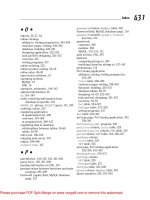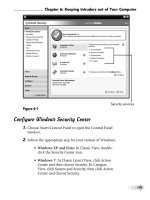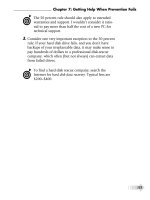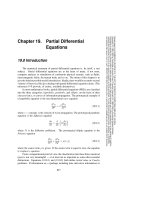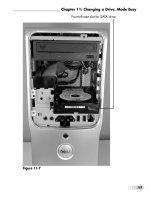differential equations workbook for dummies
Bạn đang xem bản rút gọn của tài liệu. Xem và tải ngay bản đầy đủ của tài liệu tại đây (17.89 MB, 315 trang )
Quick refresher explanations
Step-by-step procedures
Hands-on practice exercises
Ample workspace to work out problems
Tear-out Cheat Sheet
A dash of humor and fun
Go to Dummies.com
®
for videos, step-by-step photos,
how-to articles, or to shop the store!
Mathematics/Differential Equations
$16.99 US
$19.99 CN
£12.99 UK
ISBN 978-0-470-47201-9
Get the confidence and the skills you need
to master differential equations!
Need to know how to solve differential equations? This easy-to-follow,
hands-on workbook helps you master the basic concepts and work
through the types of problems you’ll encounter in your coursework. You
get valuable exercises, problem-solving shortcuts, plenty of workspace,
and step-by-step solutions to every equation. You’ll also memorize the
most-common types of differential equations, see how to avoid common
mistakes, get tips and tricks for advanced problems, improve your exam
scores, and much more!
Steven Holzner, PhD, served on
the faculty of Cornell University
and Massachusetts Institute of
Technology. He is an award-
winning author who has written
Physics For Dummies, Quantum
Physics For Dummies, and more.
100
Problems!
Detailed, fully worked-out
solutions to problems
The inside scoop on first,
second, and higher order
differential equations
A wealth of advanced
techniques, including
power series
More
than
Differential Equations
Workbook
Making Everything Easier!
™
Make sense of these difficult
equations
Improve your problem-solving
skills
Practice with clear, concise
examples
Score higher on standardized
tests and exams
Steven Holzner, PhD
Author, Differential Equations For Dummies
Holzner
Differential Equations Workbook
spine=.70"
Workbook
FOR
DUMmIES
‰
Differential Equations
Workbook
FOR
DUMmIES
‰
Differential Equations Workbook For Dummies
®
Published by
Wiley Publishing, Inc.
111 River St.
Hoboken, NJ 07030-5774
www.wiley.com
Copyright © 2009 by Wiley Publishing, Inc., Indianapolis, Indiana
Published simultaneously in Canada
No part of this publication may be reproduced, stored in a retrieval system or transmitted in any form or
by any means, electronic, mechanical, photocopying, recording, scanning or otherwise, except as permit-
ted under Sections 107 or 108 of the 1976 United States Copyright Act, without either the prior written
permission of the Publisher, or authorization through payment of the appropriate per-copy fee to the
Copyright Clearance Center, 222 Rosewood Drive, Danvers, MA 01923, (978) 750-8400, fax (978) 646-8600.
Requests to the Publisher for permission should be addressed to the Permissions Department, John Wiley
& Sons, Inc., 111 River Street, Hoboken, NJ 07030, (201) 748-6011, fax (201) 748-6008, or online at http://
www.wiley.com/go/permissions.
Trademarks:
Wiley, the Wiley Publishing logo, For Dummies, the Dummies Man logo, A Reference for the
Rest of Us!, The Dummies Way, Dummies Daily, The Fun and Easy Way, Dummies.com, Making Everything
Easier, and related trade dress are trademarks or registered trademarks of John Wiley & Sons, Inc. and/
or its af
liates in the United States and other countries, and may not be used without written permission.
All other trademarks are the property of their respective owners. Wiley Publishing, Inc., is not associated
with any product or vendor mentioned in this book.
LIMIT OF LIABILITY/DISCLAIMER OF WARRANTY: THE PUBLISHER AND THE AUTHOR MAKE NO
REPRESENTATIONS OR WARRANTIES WITH RESPECT TO THE ACCURACY OR COMPLETENESS OF THE
CONTENTS OF THIS WORK AND SPECIFICALLY DISCLAIM ALL WARRANTIES, INCLUDING WITHOUT
LIMITATION WARRANTIES OF FITNESS FOR A PARTICULAR PURPOSE. NO WARRANTY MAY BE
CREATED OR EXTENDED BY SALES OR PROMOTIONAL MATERIALS. THE ADVICE AND STRATEGIES
CONTAINED HEREIN MAY NOT BE SUITABLE FOR EVERY SITUATION. THIS WORK IS SOLD WITH THE
UNDERSTANDING THAT THE PUBLISHER IS NOT ENGAGED IN RENDERING LEGAL, ACCOUNTING, OR
OTHER PROFESSIONAL SERVICES. IF PROFESSIONAL ASSISTANCE IS REQUIRED, THE SERVICES OF
A COMPETENT PROFESSIONAL PERSON SHOULD BE SOUGHT. NEITHER THE PUBLISHER NOR THE
AUTHOR SHALL BE LIABLE FOR DAMAGES ARISING HEREFROM. THE FACT THAT AN ORGANIZATION
OR WEBSITE IS REFERRED TO IN THIS WORK AS A CITATION AND/OR A POTENTIAL SOURCE OF
FURTHER INFORMATION DOES NOT MEAN THAT THE AUTHOR OR THE PUBLISHER ENDORSES THE
INFORMATION THE ORGANIZATION OR WEBSITE MAY PROVIDE OR RECOMMENDATIONS IT MAY
MAKE. FURTHER, READERS SHOULD BE AWARE THAT INTERNET WEBSITES LISTED IN THIS WORK
MAY HAVE CHANGED OR DISAPPEARED BETWEEN WHEN THIS WORK WAS WRITTEN AND WHEN
IT IS READ.
For general information on our other products and services, please contact our Customer Care
Department within the U.S. at 877-762-2974, outside the U.S. at 317-572-3993, or fax 317-572-4002.
For technical support, please visit
www.
wiley.com/techsupport.
Wiley also publishes its books in a variety of electronic formats. Some content that appears in print may
not be available in electronic books.
Library of Congress Control Number: 2009928736
ISBN: 978-0-470-47201-9
Manufactured in the United States of America
10 9 8 7 6 5 4 3 2 1
About the Author
Steven Holzner is the award-winning author of many books, including Differential
Equations For Dummies and Physics For Dummies. He did his undergraduate work at MIT
and got his PhD at Cornell University. He’s been on the faculty of both MIT and Cornell.
To Nancy, of course.
Author’s Acknowledgments
Many people are responsible for putting this book together. My special thanks go out
to Tracy Boggier, Chrissy Guthrie, Jen Tebbe, and technical editor Jamie Song, PhD.
I’d also like to thank all the folks in Composition Services for their hard work creating
equations and laying out the book.
Publisher’s Acknowledgments
We’re proud of this book; please send us your comments through our Dummies online registration form
located at . For other comments, please contact our Customer Care
Department within the U.S. at 877-762-2974, outside the U.S. at 317-572-3993, or fax 317-572-4002.
Some of the people who helped bring this book to market include the following:
Acquisitions, Editorial, and Media Development
Senior Project Editor: Christina Guthrie
Acquisitions Editor: Tracy Boggier
Copy Editor: Jennifer Tebbe
Assistant Editor: Erin Calligan Mooney
Editorial Program Coordinator: Joe Niesen
Technical Editor: Jamie Song, PhD
Editorial Manager: Christine Meloy Beck
Editorial Assistant: David Lutton
Cover Photos: Kenneth Edward/
Photo Researchers, Inc.
Cartoons: Rich Tennant (www.the5thwave.com)
Composition Services
Project Coordinator: Lynsey Stanford
Layout and Graphics: Carrie A. Cesavice,
Reuben W. Davis, Mark Pinto, Christine Williams
Proofreaders: Laura Albert, Cynthia Fields
Indexer: Ty Koontz
Publishing and Editorial for Consumer Dummies
Diane Graves Steele, Vice President and Publisher, Consumer Dummies
Kristin Ferguson-Wagstaffe, Product Development Director, Consumer Dummies
Ensley Eikenburg, Associate Publisher, Travel
Kelly Regan, Editorial Director, Travel
Publishing for Technology Dummies
Andy Cummings, Vice President and Publisher, Dummies Technology/General User
Composition Services
Debbie Stailey, Director of Composition Services
Contents at a Glance
Introduction 1
Part I: Tackling First Order Differential Equations 5
Chapter 1: Looking Closely at Linear First Order Differential Equations 7
Chapter 2: Surveying Separable First Order Differential Equations 29
Chapter 3: Examining Exact First Order Differential Equations 59
Part II: Finding Solutions to Second and
Higher Order Differential Equations 79
Chapter 4: Working with Linear Second Order Differential Equations 81
Chapter 5: Tackling Nonhomogeneous Linear Second Order Differential Equations 105
Chapter 6: Handling Homogeneous Linear Higher Order Differential Equations 129
Chapter 7: Taking On Nonhomogeneous Linear Higher Order Differential Equations 153
Part III: The Power Stuff: Advanced Techniques 175
Chapter 8: Using Power Series to Solve Ordinary Differential Equations 177
Chapter 9: Solving Differential Equations with Series Solutions Near Singular Points 199
Chapter 10: Using Laplace Transforms to Solve Differential Equations 225
Chapter 11: Solving Systems of Linear First Order Differential Equations 249
Part IV: The Part of Tens 273
Chapter 12: Ten Common Ways of Solving Differential Equations 275
Chapter 13: Ten Real-World Applications of Differential Equations 279
Index 283
Table of Contents
Introduction 1
About This Book 1
Conventions Used in This Book 1
Foolish Assumptions 2
How This Book Is Organized 2
Part I: Tackling First Order Differential Equations 2
Part II: Finding Solutions to Second and Higher Order
Differential Equations 2
Part III: The Power Stuff: Advanced Techniques 2
Part IV: The Part of Tens 3
Icons Used in This Book 3
Where to Go from Here 3
Part I: Tackling First Order Differential Equations 5
Chapter 1: Looking Closely at Linear First Order Differential Equations. . . . . . . .7
Identifying Linear First Order Differential Equations 7
Solving Linear First Order Differential Equations That Don’t Involve Terms in y 9
Solving Linear First Order Differential Equations That Involve Terms in y 12
Integrating Factors: A Trick of the Trade 15
Answers to Linear First Order Differential Equation Problems 19
Chapter 2: Surveying Separable First Order Differential Equations. . . . . . . . . . .29
The Ins and Outs of Working with Separable Differential Equations 30
Finding Implicit Solutions 33
Getting Tricky: Separating the Seemingly Inseparable 35
Practicing Your Separation Skills 39
An Initial Peek at Separable Equations with Initial Conditions 41
Answers to Separable First Order Differential Equation Problems 43
Chapter 3: Examining Exact First Order Differential Equations . . . . . . . . . . . . . .59
Exactly, Dear Watson: Determining whether a Differential Equation Is Exact 59
Getting Answers from Exact Differential Equations 63
Answers to Exact First Order Differential Equation Problems 67
Differential Equations Workbook For Dummies
xii
Part II: Finding Solutions to Second and Higher Order
Differential Equations 79
Chapter 4: Working with Linear Second Order Differential Equations . . . . . . . .81
Getting the Goods on Linear Second Order Differential Equations 82
Finding the Solution When Constant Coef cients Come into Play 84
Rooted in reality: Second order differential equations
with real and distinct roots 86
Adding complexity: Second order differential equations with
complex roots 89
Look-alike city: Second order differential equations with real,
identical roots 91
Answers to Linear Second Order Differential Equation Problems 94
Chapter 5: Tackling Nonhomogeneous Linear Second Order
Differential Equations . . . . . . . . . . . . . . . . . . . . . . . . . . . . . . . . . . . . . . . . . . . . . . . . .105
Finding the General Solution for Differential Equations
with a Nonhomogeneous e
rx
Term 106
Getting the General Solution When g(x) Is a Polynomial 109
Solving Equations with a Nonhomogeneous Term That Involves
Sines and Cosines 112
Answers to Nonhomogeneous Linear Second Order Differential
Equation Problems 115
Chapter 6: Handling Homogeneous Linear Higher Order
Differential Equations . . . . . . . . . . . . . . . . . . . . . . . . . . . . . . . . . . . . . . . . . . . . . . . . .129
Distinctly Different: Working with Real and Distinct Roots 130
A Cause for Complexity: Handling Complex Roots 133
Identity Issues: Solving Equations When Identical Roots Are Involved 135
Answers to Homogeneous Linear Higher Order Differential Equation Problems 139
Chapter 7: Taking On Nonhomogeneous Linear Higher Order Differential
Equations . . . . . . . . . . . . . . . . . . . . . . . . . . . . . . . . . . . . . . . . . . . . . . . . . . . . . . . . . . . .153
Seeking Out Solutions of the Form Ae
rx
154
Trying for a Solution in Polynomial Form 157
Working with Solutions Made Up of Sines and Cosines 159
Answers to Nonhomogeneous Linear Higher Order Differential
Equation Problems 162
Table of Contents
xiii
Part III: The Power Stuff: Advanced Techniques 175
Chapter 8: Using Power Series to Solve Ordinary Differential Equations . . . .177
Checking On a Series with the Ratio Test 177
Shifting the Series Index 181
Exploiting the Power of Power Series to Find Series Solutions 184
Answers to Solving Ordinary Differential Equations with Power Series 188
Chapter 9: Solving Differential Equations with Series Solutions
Near Singular Points . . . . . . . . . . . . . . . . . . . . . . . . . . . . . . . . . . . . . . . . . . . . . . . . . .199
Finding Singular Points 199
Classifying Singular Points as Regular or Irregular 203
Working with Euler’s Equation 206
Solving General Differential Equations with Regular Singular Points 211
Answers to Solving Differential Equations with Series Solutions
Near Singular Points 215
Chapter 10: Using Laplace Transforms to Solve Differential Equations . . . . . .225
Finding Laplace Transforms 225
Calculating the Laplace Transforms of Derivatives 229
Using Laplace Transforms to Solve Differential Equations 231
Answers to Laplace Transform Problems 236
Chapter 11: Solving Systems of Linear First Order Differential Equations . . . .249
Back to the Basics: Adding (And Subtracting) Matrices 249
An Exercise in Muddying Your Mind: Multiplying Matrices 251
Determining the Determinant 253
More Than Just Tongue Twisters: Eigenvalues and Eigenvectors 255
Solving Differential Equation Systems 258
Answers to Systems of Linear First Order Differential Equation Problems 262
Part IV: The Part of Tens 273
Chapter 12: Ten Common Ways of Solving Differential Equations. . . . . . . . . . .275
Looking at Linear Equations 275
Scoping Out Separable Equations 275
Applying the Method of Undetermined Coef cients 276
Honing in on Homogeneous Equations 276
Examining Exact Equations 276
Differential Equations Workbook For Dummies
xiv
Finding Solutions with the Help of Integrating Factors 277
Getting Serious Answers with Series Solutions 277
Turning to Laplace Transforms for Solutions 278
Determining whether a Solution Exists 278
Solving Equations with Computer-Based Numerical Methods 278
Chapter 13: Ten Real-World Applications of Differential Equations . . . . . . . . .279
Calculating Population Growth 279
Determining Fluid Flow 279
Mixing Fluids 280
Finding Out Facts about Falling Objects 280
Calculating Trajectories 280
Analyzing the Motion of Pendulums 281
Applying Newton’s Law of Cooling 281
Determining Radioactive Decay 281
Studying Inductor-Resistor Circuits 281
Calculating the Motion of a Mass on a Spring 282
Index 283
Introduction
T
oo often, differential equations seem like torture. They seem so bad in fact that you may
be tempted to cringe or shudder when you’re assigned homework that involves ’em.
Differential Equations Workbook For Dummies may not get you to embrace differential equa-
tions with open arms, but it will improve your understanding of the pesky things. Here you
get ample practice working through the most common types of differential equations, along
with detailed solutions, so you can truly master the subject. Get ready to add “differential
equations expert” to your résumé!
About This Book
Differential Equations Workbook For Dummies is all about practicing solving differential
equations. It’s crammed full of the good stuff — and only the good stuff. Each aspect of dif-
ferential equations is addressed with some brief text to refresh your memory of the basics,
a worked-out example, and multiple practice problems. (If you’re looking for in-depth
explanation of differential equations topics, your best resource is Differential Equations
For Dummies [Wiley] or your class textbook.) So that you’re not left hanging wondering
whether your solution is right or wrong, each chapter features an answers section with all
the practice problems worked out, step by glorious step.
You can leaf through this workbook as you like, solving problems and reading solutions as
you go. Like other For Dummies books, this one is designed to let you skip around to your
heart’s content.
Conventions Used in This Book
Some books have a dozen confusing conventions that you need to know before you can
even start. Not this one. You need to keep just these few things in mind:
✓ New terms appear in italics the first time they’re presented. And like other math books,
this one also employs italics to indicate variables.
✓ Web sites appear in monofont to help them stand out. (In some cases, a Web site may
break across multiple lines. Rest assured I haven’t inserted any extra spaces or punc-
tuation; just type the address as provided.)
✓ In the answers section at the end of every chapter, the practice problems and solutions
appear in bold (the step-by-step info that follows is in regular text). Matrices and key-
words in bulleted lists are also given in bold.
2
Differential Equations Workbook For Dummies
Foolish Assumptions
Any study of differential equations takes knowledge of calculus as its starting point. You
should know how to take basic derivatives and how to integrate before reading this workbook
(and if you don’t, I recommend picking up a copy of Calculus For Dummies [Wiley] first).
Most importantly, I’m assuming you already have an in-depth resource about differential
equations available to you. This workbook is intended to give you extra practice tackling
standard differential equations concepts; it doesn’t provide detailed instruction on the fun-
damentals of differential equations. I do include some brief refresher text on each aspect
of differential equations, but if you’re brand-new to the subject, check out Differential
Equations For Dummies or your class textbook.
How This Book Is Organized
This workbook is organized modularly, into parts, following the same organizational struc-
ture as Differential Equations For Dummies. Here’s what you’re going to find in each part.
Part I: Tackling First Order Differential Equations
First order differential equations are the easiest differential equations to solve. That’s why
this part gives you practice finding solutions to linear, separable, and exact first order dif-
ferential equations.
Part II: Finding Solutions to Second and
Higher Order Differential Equations
The most interesting differential equations used in the real world are second order dif-
ferential equations. Here, you practice multiple ways of solving this type of equation. You
also get to try your hand at solving third and higher order differential equations. Things get
pretty steep pretty fast, but fortunately you have some surprising techniques at your dis-
posal, as you discover in this part.
Part III: The Power Stuff: Advanced Techniques
I’ve pulled out all the stops in Part III. In these chapters, you find some powerful solution
techniques, including power series, which you can use to convert a tough differential equa-
tion into an algebra problem and then solve for the coefficients of each power, and Laplace
transforms, which can occasionally give you the solution you’re looking for in no time.
3
Introduction
Part IV: The Part of Tens
The classic For Dummies Part of Tens provides you with a couple collections of top ten
resources. Flip to this part to find help with the ten common ways of solving differential
equations or to discover ten real-world applications for differential equations.
Icons Used in This Book
For Dummies books always use icons to point out important information; this workbook is
no different. Here’s the quick-and-dirty of what the icons mean:
This icon points out practice problems that have been worked out for you to get you off on
the right foot.
Looking for the juicy tidbits that are essential to your study of differential equations? Then
watch for paragraphs marked with this icon.
This icon denotes tricks and techniques to make your life easier (at least as it relates to solv-
ing differential equations).
Where to Go from Here
You can start anywhere you feel you need the most practice. In fact, this workbook was
written to allow you to do just that. However, if you want to follow along with Differential
Equations For Dummies or your textbook, your best bet is to start with Chapter 1.
You may also want to grab a few pieces of scratch paper. I’ve tried to leave you enough
room to work the problems right in the book, but you still might find a little extra paper
helpful.
4
Differential Equations Workbook For Dummies
Part I
Tackling First
Order Differential
Equations
In this part . . .
W
elcome to the world of first order differential equa-
tions! Here, you put your skills to the test with lin-
ear first order differential equations, which means you’re
dealing with first order derivatives that are to the first
power, not the second or any other higher power. You
also work with separable first order differential equations,
which can be separated so that only terms in y appear on
one side of the equation and only terms in x appear on the
other side (okay, okay, constants can appear on this side
too). Finally, you practice solving exact differential
equations.
Chapter 1
Looking Closely at Linear First
Order Differential Equations
In This Chapter
▶ Knowing what a first order linear differential equation looks like
▶ Finding solutions to first order differential equations with and without y terms
▶ Employing the trick of integrating factors
O
ne important way that you can classify differential equations is as linear or nonlinear.
A differential equation is considered linear if it involves only linear terms (that is,
terms to the power 1) of y, y', y", and so on. The following equation is an example of a linear
differential equation:
Nonlinear differential equations simply include nonlinear terms in y, y', y", and so on. This
next equation, which describes the angle of a pendulum, is considered a nonlinear differen-
tial equation because it involves the term sin θ (not just θ):
This chapter focuses on linear first order differential equations. Here you have the chance
to sharpen your linear-equation-spotting eye. You also get to practice solving linear first
order differential equations when y is and isn’t involved. Finally, I clue you in to a little (yet
extremely useful!) trick o’ the trade called integrating factors.
Identifying Linear First Order
Differential Equations
Here’s the general form of a linear differential equation, where p(x) and q(x) are functions
(which can just be constants):
8
Part I: Tackling First Order Differential Equations
2. Is the following a linear first order
differential equation?
Solve It
1. Is this equation a linear first order
differential equation?
Solve It
A. Yes.
This equation is a linear first order differ-
ential equation because it involves solely
first order terms in y and y'.
Q. Is this equation a linear first order
differential equation?
Following are some examples of linear differential equations:
For a little practice, try to figure out whether each of the following equations is linear or
nonlinear.
9
Chapter 1: Looking Closely at Linear First Order Differential Equations
Solving Linear First Order Differential
Equations That Don’t Involve Terms in y
The simplest type of linear first order differential equation doesn’t have a term in y at all;
instead, it involves just the first derivative of y, y', y", and so on. These differential equations
are simple to solve because the first derivatives are easy to integrate. Here’s the general form
of such equations (note that q(x) is a function, which may be a constant):
Take a look at this linear first order differential equation:
Note that there’s no term in just y. So how do you solve this kind of equation? Just move the
dx over to the right:
dy = 3dx
4. Is the following a linear first order
differential equation?
Solve It
3. Is this equation a linear first order
differential equation?
Solve It




